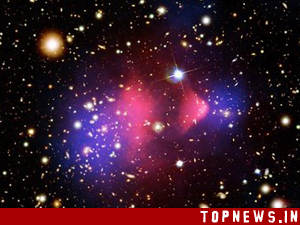When mammoth galaxy clusters collide in a ‘cosmic free-for-all’
 Washington, April 17 : By combining information from three different telescopes, scientists are learning what happens when some of the largest galaxy clusters in the Universe collide with each other in a cosmic free-for-all.
Washington, April 17 : By combining information from three different telescopes, scientists are learning what happens when some of the largest galaxy clusters in the Universe collide with each other in a cosmic free-for-all.
Galaxy clusters are the largest objects bound by gravity in the Universe.
Using data from NASA's Chandra X-ray Observatory, Hubble Space Telescope and the Keck Observatory on Mauna Kea, Hawaii, astronomers were able to determine the three-dimensional geometry and motion in the system MACSJ0717.5+3745 (or MACSJ0717 for short) located about 5.4 billion light years from Earth.
The researchers found that four separate galaxy clusters are involved in a triple merger, the first time such a phenomenon has been documented.
In MACSJ0717, a 13-million-light-year-long stream of galaxies, gas and dark matter, known as a filament, is pouring into a region already full of galaxies.
Like a freeway of cars emptying into a full parking lot, this flow of galaxies has caused one collision after another.
"In addition to this enormous pileup, MACSJ0717 is also remarkable because of its temperature," said Cheng-Jiun Ma of the University of Hawaii and lead author of the study.
"Since each of these collisions releases energy in the form of heat, MACS0717 has one of the highest temperatures ever seen in such a system," he added.
While the filament leading into MACJ0717 had been previously discovered, these results show for the first time that it was the source of this galactic pummeling.
The evidence is two-fold.
First, by comparing the position of the gas and clusters of galaxies, the researchers tracked the direction of clusters' motions, which matched the orientation of the filament in most cases.
Secondly, the largest hot region in MACSJ0717 is where the filament intersects the cluster, suggesting ongoing impacts.
"MACSJ0717 shows how giant galaxy clusters interact with their environment on scales of many millions of light years," said team member Harald Ebeling, also from University of Hawaii.
"This is a wonderful system for studying how clusters grow as material falls into them along filaments," he added. (ANI)